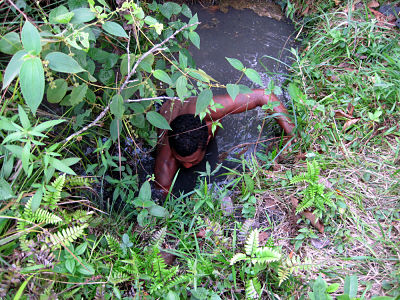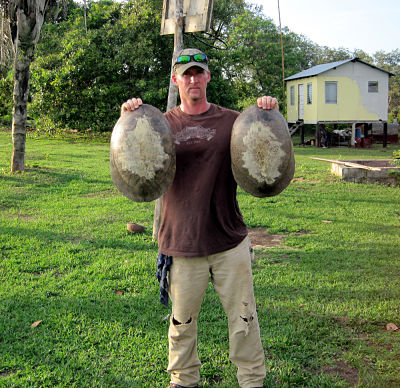Hard Work in Belize
by Dr. Thomas Rainwater on May 12, 2010

On April 30, we set out to survey Cook's Lagoon, Cook's Creek, and Mussel Creek in central Belize. These are areas that Don Moll surveyed for Dermatemys in the early 1980s. Mussel Creek leads to Cook's Creek, which then leads to Cook's Lagoon. Our plan was to paddle our way to Cook's Lagoon before nightfall and then after dark make our way back to our vehicle, surveying the lagoon, Cook's Creek, and Mussel Creek along the way. We had been warned by locals that Cook's Creek was choked with vegetation, and it would be difficult at best to make it through. They were correct.


After the first few hundred meters from Mussel Creek, the surface of Cook's Creek became increasingly covered in lilypads such that in some places it was difficult to see any water. Shortly after, the creek began to narrow, and we began to encounter thick patches of brush that had grown over from both banks and had become entangled. We spent the next few hours chopping holes through the brush and pulling the canoe through. Finally, the water became too shallow to paddle effectively, so we got out and dragged the canoe up the creek. At sunset, we climbed out of the creek and followed it by land. Eventually, the creek, almost dry at this point, meandered its way to a large swampy depression that contained occasional patches of shallow water and was dominated by think vegetation (Eleocharis and Typha). This was not Cook's Lagoon (we hadn't been able to go far enough). With the creek too shallow to proceed by canoe and the lagoon several km away, we decided to work our way back to the upper portion of the creek where the water was deeper and begin our survey there. We surveyed this section of Cook's Creek and the stretch of Mussel Creek that led back to the landing. No turtles were seen.
On May 1, we drove along the Belize River through Burrell Boom, Scotland Halfmoon, Bermudian Landing, Double Head Cabbage, and Willows Bank in hopes of finding some local residents that might be able to provide us with information on Dermatemys in the Belize River. We eventually stopped at the Community Baboon Sanctuary in Bermudian Landing. There we met one of the Sanctuary guides who turned out to be married to one of the most respected turtle fisherman in the area. We spoke with him and he agreed to help us organize a trip up the river to survey Dermatemys. As we were getting into the car to go meet the boat driver and plan the trip, the fisherman's two young daughters walked up with a Dermatemys shell (carapace) that someone had recently left there. It was from this year's harvest. We thanked them, collected morphometric data on the shell, and headed to the next village, Double Head Cabbage. There we were introduced to a man who had a boat and motor, and he agreed to take us upriver the following day. He also mentioned that he had a few small hickatees in a pond behind his house and invited us over later that afternoon to see them. As we walked back to the car, I noticed a Dermatemys plastron (also from this year's harvest) in the dirt next to a pile of burned trash. We picked it up and kept it to measure later.
That afternoon we arrived at the man's house in St. Paul Bank to see the juvenile turtles. He and some of his friends walked us down behind the house to a small hole partially hidden by dense vegetation. One of the man's friends enthusiastically hopped down into the hole and into chest-deep water where he began feeling on the bottom and sides of the pool for turtles. There had been the noticeable stench of death near the pool upon our arrival but we didn't think much of it at the time. But, as the man continued to feel for turtles, the carcass of a partially decomposed dog surfaced and bobbled next to him, explaining the stench. The man nonchalantly nudged the carcass aside and kept searching. Within minutes he emerged from the pool with a juvenile female Dermatemys, which we measured and photographed.

Before we left, a young man from a few houses down brought us two more Dermatemys shells (carapaces) from this year's harvest. We measured them, confirmed plans for the next day, and headed back to our base of operations about an hour's drive away.
